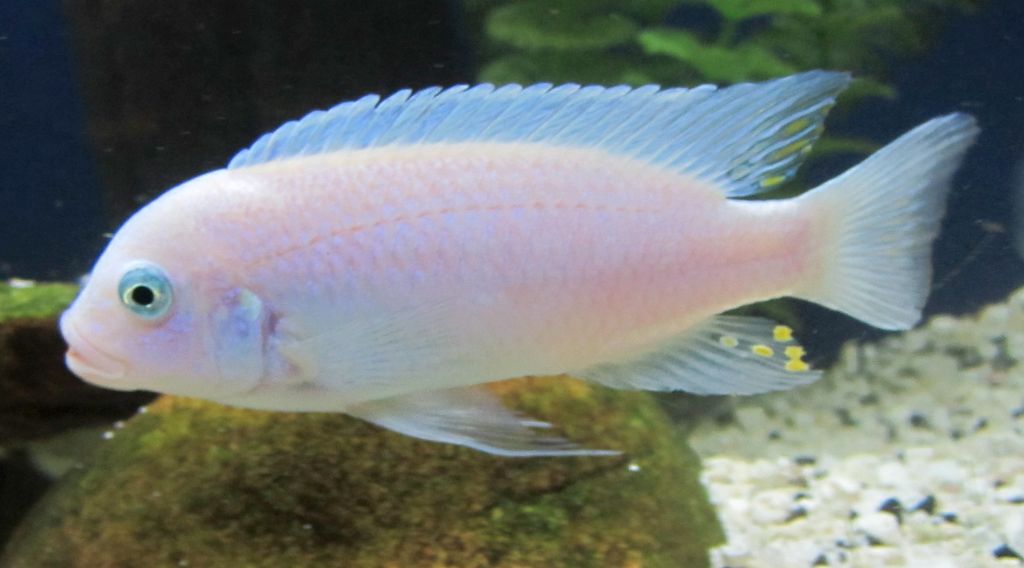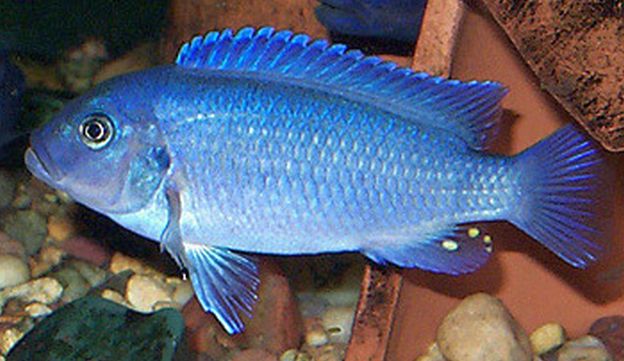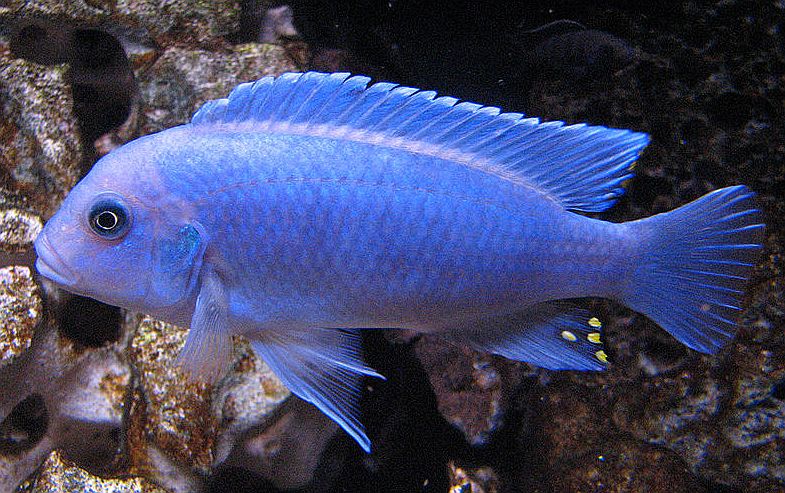The Cobalt Blue Zebra Cichlid (Metriaclima callainos) hail from the sandy shallows and deeper rocky waters of lake Malawi, Africa and is known by tropical fish keeping enthusiasts as the Cobalt Blue, Cobalt Blue Cichlid, Zebra Malawi Cichlid, Cobalt Blue Mbuna and Cobalt Zebra.
The entire body of the male Cobalt Blue Zebra is a consistent light blue color with no faint zebra banding. There are four orange egg shaped spots on the anal fin, which become important during breeding. Females are a lighter gray blue color throughout.
Metriclima estherae is a very similar species that has a blue version that is often misidentified as Metriaclima callainos. The two species can be differentiated by the faint horizontal banding on Metriclima estherae.
There are several other African zebra color variations that include the Red or Cherry Zebra (which is colored red/orange), the Pearl Zebra (which is a pearl white color), and the Orange Blotch Zebra (OB), which has black blotches on a pink orange background.
Cobalt Blue Zebra Cichlids are a long lived, relatively semi aggressive species, that do best in community aquariums with a dark sandy bottom , plenty of small loose rocks or gravel for burrowing, and enough rocks, caves, and tunnels for the fish to set up separate territories.
They also need plenty of room for swimming, so a 55 gallon or larger tank is mandatory. Like all mbuna, Cobalt Blue Zebra Cichlids enjoy having plants in their tank, but because they constantly rearrange the substrate will uproot them and eventually have them as part of their diet.
Optimal conditions for keeping Metriaclima callainos is a water temperature of 75 to 80 degrees, and a pH balance as close to 9.0 as possible. Many tropical fish keeping enthusiasts use a laterite based substrate to help maintain the necessary high pH and alkalinity required for keeping these cichlids, but clean water and proper pH are extremely important in maintaining healthy mbuna aquariums.
In general, because of their aggressiveness, Cobalt Blue Zebra Cichlids should only be kept with other Mbunas. They are compatible with Auratus, Johanni, Kenyi, Lemon Yellow, Orange Blotch, Pindani, Red Zebra and only the Synodontis Catfish species. They are usually too aggressive to keep with Peacock Cichlids and Haplochromis. In a 75 to 100 gallon tank, a grouping of 10 or more mbunas is recommended to spread out aggressive behavior.
The Cobalt Blue Zebra Cichlid is a maternal mouth brooder that build nests in the bottom substrate from small rocks when they are ready to breed.
To achieve the best results, its best to keep one male with three or more females. When the male is ready to breed, his colors
become enhanced and he will establish a territory in the tank.
When a female is ready to spawn, she will enter his territory and begin to aggressively interact with the male until she releases a couple of eggs into the gravel nest or on a flat rock. She will immediately pick the eggs up into her mouth, while the male displays the egg like spots (which are the same size and color as the real eggs) on his anal fin. The female will nip at the egg like spots on the males anal fin, to stimulate him into releasing his sperm into the water. When the sperm reaches the female, the real eggs that she picked up in her mouth become fertilized. This process continues until she has between 10 to 50 fertilized eggs in her mouth.
The female will keep the eggs in her mouth for about a week until they all hatch out. For up to a month, the fry will seek safety by rushing into the females mouth at any sign of danger. During this period, she will usually not eat any food until the fry are able to fend for themselves. Once the fry can take care of themselves, the female stops letting them into her mouth. The fry can be fed crushed flake food, daphnia or baby brine shrimp. The entire brooding process is apparently very stressful for the female which is why most breeders remove the female to a separate brooding tank.
Adult Cobalt Blue Zebras are primarily vegetarians and need a vegetable based diet. They will eat flake foods, leafy seaweeds, Spirulina flakes, cichlid pellets and freeze dried or frozen foods. They should not be fed a constant diet of protein rich foods like live worms or live brine shrimp. These foods can bloat and kill the fish, but an occasional treat of krill, plankton, or frozen brine shrimp
will be eagerly accepted and should cause no harm.
True Cobalt Blue Zebra Cichlids are hard to find and pricey when available for purchase; usually as juveniles between 1″ to 1-1/2″ or as young adults at 4″ – 5″.
Minimum Tank Size: 55 gallons
Care Level: Moderately Difficult
Temperament: Semi aggressive
Aquarium Hardiness: Moderately hardy
Water Conditions: 72-83° F, KH 10-15, pH 7.8-8.6
Max. Size: 5 – 6″
Color Form: Blue, White
Diet: Herbivore
Compatibility: OK with other Mbunas
Origin: Lake Malawi, Africa
Family: Cichlidae
Lifespan: 5 – 10 years
Aquarist Experience Level: Intermediate





